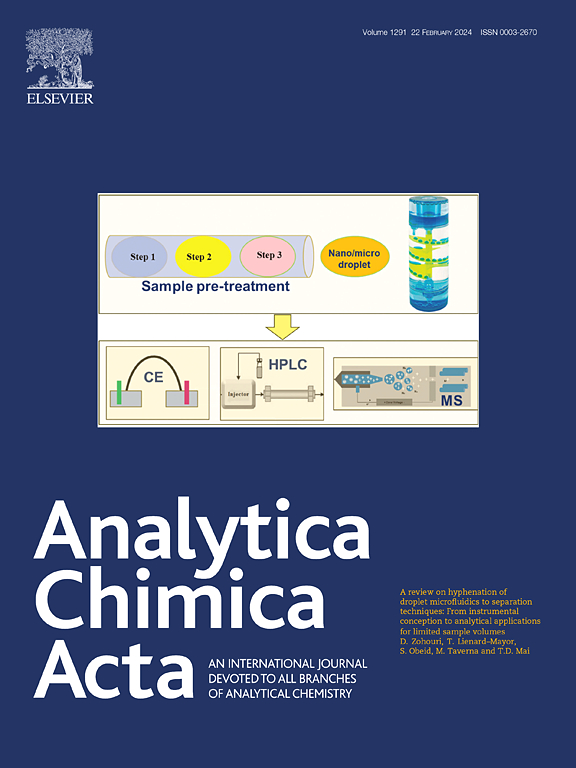碳纳米管铅笔纸一次性生物传感器对食源性大肠杆菌的电化学检测
IF 6
2区 化学
Q1 CHEMISTRY, ANALYTICAL
引用次数: 0
摘要
在本研究中,开发了电化学柔性纸基生物传感器,用于快速灵敏地检测大肠杆菌,这是一种公共卫生和食品工业中备受关注的病原体。电极是由一个简单的铅笔绘制方法,利用商业的,具有成本效益的切割工具。使用自动切割工具形成导电石墨图案,使铅笔绘制的纸基电极具有高再现性。将多克隆大肠杆菌抗体杂交的多壁碳纳米管(MWCNTs)固定在工作电极表面,构建生物传感器。结果采用循环伏安法(CV)和差分脉冲伏安法(DPV)对生物传感器的抗大肠杆菌性能进行了评价。在固定和性能条件优化结果中,所研制的传感器在7.2 pH、10μg条件下效果最佳。mL-1 Ab-MWCNT偶联物负载和30分钟孵育时间。铅笔绘制的柔性纸基生物传感器显示出100-107 CFU的线性范围。低检出限(LOD)为2.6 × 101 CFU.mL-1。该传感器重复性高,相对标准偏差(RSD) %为2.8。该传感器对不同的培养环境具有良好的选择性,对苹果汁中大肠杆菌的检测效果良好。此外,所开发的生物传感器还成功检测出一株从街头小吃中分离出来的野生型大肠杆菌,并在本研究中被遗传证实为大肠杆菌。本研究结果表明,一次性纸基铅笔绘制的柔性电极可用于开发低成本、高灵敏度和选择性的大肠杆菌生物传感器。据我们所知,这是第一个使用铅笔绘制方法制作电极来检测大肠杆菌并将其应用于实际样品的报道。本文章由计算机程序翻译,如有差异,请以英文原文为准。


Electrochemical detection of foodborne Escherichia coli using carbon nanotube-incorporated pencil-drawn paper-based disposable biosensors
Background
In this study, electrochemical flexible paper-based biosensors were developed for rapid and sensitive detection of Escherichia coli, a pathogen and a significant concern in both public health and the food industry. The electrodes were fabricated by a simple pencil drawing method utilizing a commercial, cost-effective cutting tool. Using automated cutting tool to form the conductive graphite patterns enabled the fabrication of pencil-drawn paper-based electrodes with a high reproducibility. The polyclonal E. coli antibody-hybridized multi-walled carbon nanotubes (MWCNTs) were immobilized onto the working electrode surface to construct the biosensors.
Results
The performance of the biosensors against E. coli was evaluated using cyclic voltammetry (CV) and differential pulse voltammetry (DPV) techniques. To the immobilization and performance conditions optimization results, the developed sensor demonstrated the best results at 7.2 pH, 10 μg mL−1 Ab-MWCNT conjugate loadings and 30-min incubation time. The pencil-drawn flexible paper-based biosensors showed a linear range of 10°–107 CFU mL−1 with a low limit of detection (LOD) of 2.6 × 101 CFU mL−1. The sensor exhibited high repeatability with a low Relative Standard Deviation (RSD) % of 2.8. The sensors demonstrated remarkable selectivity against various culture environments and good performance in detecting E. coli in apple juices as real samples. In addition, the developed biosensor successfully detected a wild-type E. coli strain which was isolated from a street food and genetically confirmed as E. coli in this study.
Significance
Our results suggested that disposable paper-based pencil-drawn flexible electrodes can be used to develop low-cost biosensors with high sensitivity and selectivity against E. coli. To the best of our knowledge, it is the first report using the pencil-drawing method for electrode fabrication for detection of E. coli and its application in real samples.
求助全文
通过发布文献求助,成功后即可免费获取论文全文。
去求助
来源期刊

Analytica Chimica Acta
化学-分析化学
CiteScore
10.40
自引率
6.50%
发文量
1081
审稿时长
38 days
期刊介绍:
Analytica Chimica Acta has an open access mirror journal Analytica Chimica Acta: X, sharing the same aims and scope, editorial team, submission system and rigorous peer review.
Analytica Chimica Acta provides a forum for the rapid publication of original research, and critical, comprehensive reviews dealing with all aspects of fundamental and applied modern analytical chemistry. The journal welcomes the submission of research papers which report studies concerning the development of new and significant analytical methodologies. In determining the suitability of submitted articles for publication, particular scrutiny will be placed on the degree of novelty and impact of the research and the extent to which it adds to the existing body of knowledge in analytical chemistry.
 求助内容:
求助内容: 应助结果提醒方式:
应助结果提醒方式:


